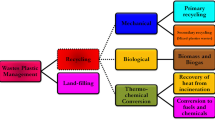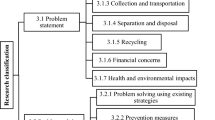Abstract
The high quality of syngas from gasification and cleaning systems can be utilized for energy generation or commodity chemicals. To evaluate the quality of syngas from waste gasification and to obtain design factors for commercial scale, we identified the characteristics of particles depending on the cleaning units in pilot scale. The particle size distribution, amount of particles and heavy metals were analyzed at gasifier and each cleaning unit which are quenching scrubber, venturi scrubber, neutralization scrubber, desulfurization scrubber, and wet electrostatic precipitator. As a result, about 99.98 % of the particles were removed through 5 cleaning systems, from 51,226 mg/Nm3 at gasifier to 12 mg/Nm3 at WESP, and were ostensibly undetectable. Moreover, the minimum size of particles that could be eliminated was different depending on wet cleaning systems. The particle size at 90 % in the cumulative was generated up to 24.029 µm at the gasifier and the removed particle size distribution at WESP ranged from 0.370 to 12.795 µm. From the particulate matters point of view, the syngas from waste gasification with cleaning systems can be properly utilized for energy recovery systems.
Graphical Abstract










Similar content being viewed by others
References
Korea Energy Management Corporation, Ministry of Knowledge Economy (2012) 2012 New and renewable energy white paper, Korea
Woolcock PJ, Brown RC (2013) A review of cleaning technologies for biomass-derived syngas. Biomass Bioenergy 52:54–84. doi:10.1016/j.biombioe.2013.02.036
Asadullah M (2014) Biomass gasification gas cleaning for downstream applications: a comparative critical review. Renew Sustain Energy Rev 40:118–132. doi:10.1016/j.rser.2014.07.132
E4tech, NNFCC project Final report (2009) Review of technologies for gasification of biomass and wastes. NFFCC project 09/2008
Hasler P, Nussbaumer T (1999) Gas cleaning for IC engine applications from fixed bed biomass gasification. Biomass Bioenergy 16:385–395. doi:10.1016/S0961-9534(99)00018-5
Gu JH (2008) Determination of optimum operation conditions for horizontal compressed-type fixed-bed waste gasification and melting furnace. Dissertation, university of Ajou, Korea
Park SB (2009) Characteristics of air pollution and prevention facility. Instrum Technol, Korea, pp 112–119
Kim SS, Yang HM (2001) Fine particle control technology for energy and environment. In: Kim KT, Choi JY (eds) Removal technology trends for fine particles. Aerosol particle technology, Kaist (Korea Advanced Institute of Science and Technology), Korea
Kilpimaa S, Runtti H, Kangas T, Lassi U, Kuokkanen T (2015) Physical activation of carbon residue from biomass gasification: novel sorbent for the removal of phosphates and nitrates from aqueous solution. J Ind Eng Chem 21:1354–1364. doi:10.1016/j.jiec.2014.06.006
Menad N (2007) Recycling of auto shredder residue. J Hazard Mater A139:481–490. doi:10.1016/j.jhazmat.2006.02.054
Santini A, Passarini F, Vassura I, Serrano D, Dufour J, Morselli L (2012) Auto shredder residue recycling: mechanical separation and pyrolysis. Waste Manag 32:852–858. doi:10.1016/j.wasman.2011.10.030
Buekens A, Zhou X (2014) Recycling plastics from automotive shredder residues: a review. J Mater Cycles Waste Manag 16:398–414. doi:10.1007/s10163-014-0244-z
Hiratsuka J, Sato N, Hideto Y (2014) Current status and future perspectives in end-of-life vehicle recycling in Japan. J Mater Cycles Waste Manag 16:21–31. doi:10.1007/s10163-013-0168-z
Joung HT, Seo YC, Kim KH, Hong JH, Yoo TW (2007) Distribution and characteristics of pyrolysis products from automobile shredder residue using an experimental semi-batch reactor. Korean J Chem Eng 24:996–1002
Official test methods of waste materials (2015) The Department of the environment in Korean, Korea
Kim NR, Yoo YD, Gu JH, Lee HH, Kwak TH (2008) A Study on the characteristics of heavy metals in gasification and melting process of solid waste (in Korean). J Korea Soc Waste Manag 25:371–381
Couto ND, Silva VB, Monteiro E, Rouboa A (2015) Assessment of municipal solid wastes gasification in a semi-industrial gasifier using syngas quality indices. Energy 93:864–873. doi:10.1016/j.energy.2015.09.064
Niu M, Huang Y, Jin B, Wang X (2014) Oxygen gasification of municipal solid waste in a fixed-bed gasifier. Chin J Chem Eng 22:1021–1026. doi:10.1016/j.cjche.2014.06.026
Arena U (2012) Process and technological aspects of municipal solid waste gasification. A review. Waste Manag 32:625–639. doi:10.1016/j.wasman.2011.09.025
Official test methods of air pollution (2007) The Department of the environment in Korean, Korea
Official test methods of water quality (2004) The Department of the environment in Korean, Korea
Sadowski Z, Maliszewska IH, Grochowalska B, Polowczyk I, Kozlecki T (2008) Synthesis of silver nanoparticles using microorganisms. Mater Sci Poland 26:419–424
Korean Water Quality Standards (2013) The Department of the environment in Korean, Korea
Acknowledgments
This work was supported by the New and Renewable Energy Core Technology Program of the Korea Institute of Energy Technology Evaluation and Planning (KETEP) granted financial resource from the Ministry of Trade, Industry and Energy, Republic of Korea (No. 20123010100010) and Korea Ministry of Environment(MOE) as “Waste-to-Energy Technology Development Project” (No. 2013001530001).
Author information
Authors and Affiliations
Corresponding author
Electronic supplementary material
Below is the link to the electronic supplementary material.
Rights and permissions
About this article
Cite this article
Min, J., Nam, SB., Kim, NR. et al. A study on the characteristics of particulate matter in the syngas produced from the waste gasification with cleaning systems for energy utilization. J Mater Cycles Waste Manag 19, 1155–1165 (2017). https://doi.org/10.1007/s10163-016-0501-4
Received:
Accepted:
Published:
Issue Date:
DOI: https://doi.org/10.1007/s10163-016-0501-4




